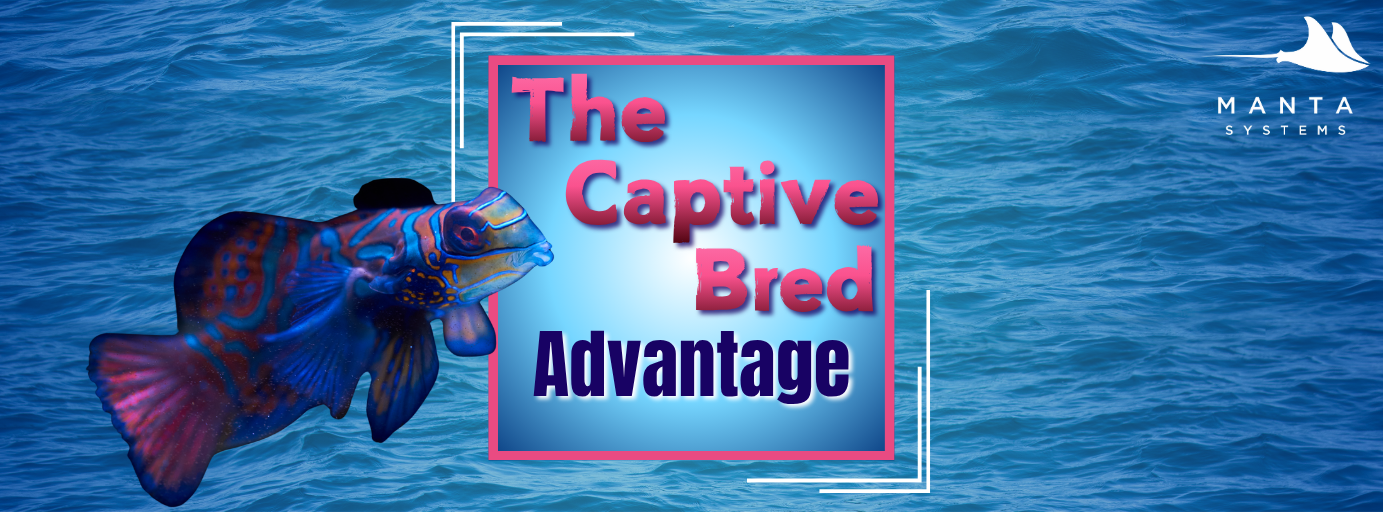
𝐓𝐡𝐞 𝐂𝐚𝐩𝐭𝐢𝐯𝐞-𝐁𝐫𝐞𝐝 𝐀𝐝𝐯𝐚𝐧𝐭𝐚𝐠𝐞: 𝐇𝐨𝐰 𝐓𝐡𝐞𝐲 𝐀𝐫𝐞 𝐑𝐞𝐯𝐨𝐥𝐮𝐭𝐢𝐨𝐧𝐢𝐳𝐢𝐧𝐠 𝐭𝐡𝐞 𝐇𝐨𝐛𝐛𝐲
If you know me at all, you know how passionate I am about aquacultured (captive bred) fish. I’ll never forget my first Mandarin Dragonet. It was a stunning, wild-caught fish that danced across the live rock with natural grace. Despite my best efforts, it never accepted prepared foods, slowly wasting away as I watched, helpless. That heartbreaking experience, once common in our hobby, is exactly why the captive-bred revolution represents the most important shift in marine aquatics in a generation.
Today, the joy of watching my captive-bred Mandarin Dragonet eagerly chase down pellets just days after introduction was the polar opposite of that first experience. We now have a meaningful choice: wild-caught fish or those born and raised in aquaculture facilities. As both a scientist and hobbyist, the decision has become increasingly clear. This isn't just about sustainability; it's about survival, hardiness, and finally stacking the odds in our favor.
What "Captive-Bred" Really Means
Let's clarify the terminology that matters. A captive-bred fish completes its entire life cycle—from egg to adult—in a controlled aquaculture environment. This differs significantly from captive-raised or maricultured fish, which are typically wild-caught as juveniles and then grown out in ocean pens.
True captive-bred fish have never experienced the ocean. They've been conditioned from their first breath to accept prepared foods and thrive in aquarium conditions. This fundamental difference creates a fish perfectly adapted to life in our home systems.
Tamara’s Pro Tip: When shopping, look for specific labels like "Captive-Bred" or "Aquacultured." Reputable breeders and sellers are proud to share their origins—don't hesitate to ask for proof.
The Compelling Case for Captive-Bred Fish
1. Superior Hardiness and Resilience
Perhaps the most significant advantage for hobbyists is the remarkable resilience of captive-bred fish. These animals arrive accustomed to stable water parameters, artificial lighting, and aquarium noises, making their transition into your system remarkably smooth.
Their disease resistance is notably higher since they've never been exposed to common wild pathogens like marine ich or velvet. They enter your system without this hidden baggage, giving them a stronger foundation for long-term health.
The Science Behind Their Strength:
-
Inadvertent Selective Breeding: In hatcheries, the strongest, fastest-growing larvae survive to be sold. Over generations, this selects for traits advantageous in captivity, including disease resistance and adaptability to prepared foods.
-
Microbiome Advantage: Wild fish arrive with complex ocean microbiomes, while captive-bred fish develop microbiomes from controlled rearing systems, making them less susceptible to bacterial imbalances common in home aquariums.
Tamara’s Pro Tip: This genetic hardiness keeps giving. Many captive-bred fish outlive their wild-caught counterparts because they avoid the cumulative stress of capture and transport.
2. Proven Sustainability Benefits
The environmental advantages are substantial and meaningful. By choosing captive-bred, you eliminate your contribution to bycatch and habitat damage associated with wild collection methods.
For species like the iconic Banggai Cardinalfish—whose wild populations were severely impacted by collection—captive breeding has provided a sustainable alternative. While well-managed wild collection can support local economies in some regions, captive breeding offers a pressure-free solution that helps ensure the hobby's future.
Tamara’s Pro Tip: The traceability of captive-bred fish creates a more ethical supply chain. You know exactly where your fish originated, supporting transparent practices.
3. Enhanced Adaptability and Personality
Fish raised in human care demonstrate remarkable adaptability to aquarium life. I've observed my captive-bred Clownfish showing far bolder behavior than wild counterparts—they simply aren't programmed to see humans as threats.
Their enthusiastic feeding response becomes a particular joy. They recognize you as their food source, often greeting you at the glass with anticipation that wild-caught fish may never display.
Addressing Common Concerns with Facts
"The Price Seems Higher"
While the initial cost is often greater, this represents a classic "pay now or pay later" scenario. Consider the true cost comparison:
Wild-Caught: Lower purchase price + potential medication costs + risk of losing the fish
Captive-Bred: Higher purchase price + dramatically improved survival odds
The long-term economics clearly favor captive-bred fish when you factor in their significantly higher survival rates.
"Color Patterns Aren't as Vibrant"
This criticism hasn't aged well. Advanced breeding programs have not only matched wild coloration but in some cases created enhanced variations through selective breeding. Captive-bred Clownfish now display patterns and colors exceeding what nature typically produces.
"The Selection is Limited"
This remains the only valid limitation, but the landscape is changing rapidly. From humble beginnings with Clownfish and Cardinals, we now have:
-
Multiple Tang species (including Yellow and Pacific Blue)
-
Various Angelfish (Coral Beauty, Flame, Potter's)
-
Numerous Gobies and Blennies
-
The once-"impossible" Mandarin Dragonet
Tamara’s Pro Tip: When Biota launched their first captive-bred Yellow Tangs, overwhelming demand sold them out immediately—sending a powerful market signal that accelerated breeding programs for other challenging species.
How You Can Support the Revolution
Your choices directly shape the industry's future:
Vote With Your Wallet: Each captive-bred purchase signals market demand for sustainable practices.
Request Captive-Bred Options: Ask your local fish store to stock more aquacultured fish. Consumer demand drives inventory decisions.
Share Success Stories: Post about your thriving captive-bred fish online. Your experiences encourage others to make sustainable choices.
Consider Breeding Projects: Even breeding simpler species like Neon Gobies contributes to our collective knowledge and availability.
Tamara’s Pro Tip: The next frontier is captive-bred invertebrates. Seek out captive-bred Peppermint Shrimp and snails—the same principles of hardiness and sustainability apply perfectly.
The Clear Path Forward
So, when I look at my captive-bred Mandarin Dragonet, eagerly snatching pellets from the water column, I don't just see a healthy fish. I see the future of the hobby—a future where success stories are the norm, and heartbreaking losses are a lesson of the past.
Choosing captive-bred has transformed from a niche preference to an intelligent, responsible decision that benefits you, your fish, and our oceans. It's the ultimate win-win scenario. Next time you're at the fish store, look for that "Captive-Bred" label—your tank, and the reef, will thank you for it.
Tamara’s Final Pro Tip: Support local fish stores that proudly prioritize and display captive-bred livestock. These retailers are actively investing in the hobby's future, and they deserve our recognition and business.







.png)